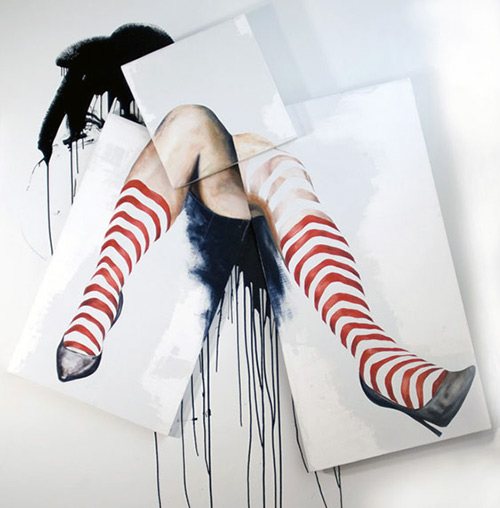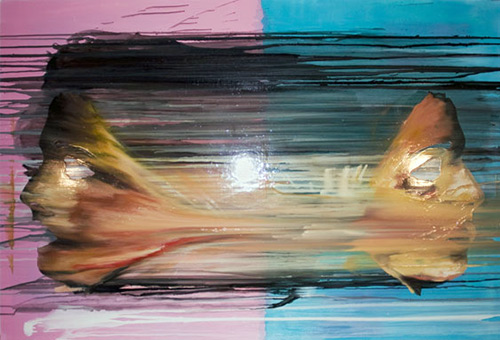Expressing ideas about art in a theoretical or systematic fashion is a quick way to either set yourself up for a failure or a tired and clichéd success. I don’t want either of those. Art is such a great outlet to ask questions you don’t need an absolute answer to. I think there are too many currents in the art world focused on creating these neatly packaged systems to engage with art. The academic world (MFA programs) has put a lot of energy into celebrating and championing a dry formulaic way of experiencing and creating art. I’m more interested in allowing for diverse ways of interacting with the art. I don’t want to tell people what to think about what I create, rather I expect a willing viewer to intersect and interact with something I have made. I don’t want anyone to walk away with the feeling of ‘oh I get it’, and then that’s it. (Keck)
I recently came across Erika Keck’s mixed media installations at Envoy gallery in the Lower East Side. I was somewhat disturbed by the intensity of her work, but also captivated by the spontaneity of how each piece was conceived. If anything, I think her installations need more space for them to breathe and to do it justice. The following is a Q & A between Erika and Envoy.
Would you agree that, in your case, the creative process is a cocktail of instinct, skill, culture and a highly creative feverishness? That it is a particular state in which everything happens very quickly, a mixture of consciousness and unconsciousness, of fear and pleasure?
YES! A cocktail I’ll take: shaken not stirred! I think the creative process functions best when it’s a lucid interaction of all those elements. The creative act, for myself, is a constant negotiation between the mind, the subconscious, personal interests & external influences. It demands a great deal of focus, attentiveness to the world, constantly doing—-and experimenting. I’ve often said the studio needs to be more like a laboratory and less like a factory. I allow myself to embrace the fear & put myself into a heightened state to produce this work. I battle with the work, it’s not something predictable or systematic—-it’s like trying to tame a wild horse.
Do you do away with whatever comes from habit, from technical routine, whatever keeps the viewer from getting directly and exclusively at the essential (which is what you determine it to be)?
The only thing I wish to keep consistent is the notion of making a painting; I have a deep love for the act of creating a painting and a huge respect for the history of painting. Whatever happens within that framework of painting is fair game. Essentially it’s my natural impulse to play, pervert, and warp that structure as much as I can. That attitude allows for more possibilities to occur rather than simply engaging in a completely redundant and repetitive task. For example in some of the pieces I’ve done away with the canvas and stretcher bars all together. It’s all just sheets of paint that are allowed to fold and drape as they will. It allows the paint take on some unexpected sculptural qualities, to do things it was not intended to do. Yet other paintings that are more about traditional techniques of creating illusion, color & composition. I’ve really been pushing myself to allow different seemingly contradictory, modes of thinking exist together: there’s some more ‘cool’ cerebral works sitting next to ‘hot’ more expressionistic paintings. I’m after the tension that’s created when opposites are forced to co-exist together. Foucault’s lecture Heterotopias’ is coming to mind here.
Theorizing prevents a work from coming into direct, media-free contact with its viewer (its reader, its listener). Is this why you refuse to express your ideas on art in too systematic a fashion? Or is it out of fear it would stifle your creative unconscious or because it would allow the work to be turned into a simplistic message?
Expressing ideas about art in a theoretical or systematic fashion is a quick way to either, set yourself up for a failure or a tired and clichéd success. I don’t want either of those. Art is such a great outlet to ask questions you don’t need an absolute answer to. I think there are too many currents in the art world focused on creating these neatly packaged systems to engage with art. The academic world (MFA programs) has put a lot of energy into celebrating and championing a dry formulaic way of experiencing and creating art. I’m more interested in allowing for diverse ways of interacting with the art. I don’t want to tell people what to think about what I create, rather I expect a willing viewer to intersect and interact with something I have made. I don’t want anyone to walk away with feeling of ‘oh I get it’, and then that’s it.
You have once stated that you like art to be contradictory and confusing. This is of course directly tied to the times the work was created in. Some artists leave remarkable things, which a 100 years later, don’t work at all. Is this a concern to you?
I’m definitely not going to worry about what a work of art will do in 100 years, that’s nearly impossible to predict. I’m more worried about the here and now with what concerns me today. I do strive to make pieces that can touch on something specific and personal, something of the times, as well as something more universal & constant— by doing so I hope that what I make today will still hold some value 100 years from now.
When viewed from a distance, there is a seductiveness, a creamy beauty about the colors in your paintings, but viewed close up, everything seems more destructive, the key colors being those of bone, blood and flesh. Bacon once spoke about ‘this great beauty of the color of meat.’ Would it be wrong to say that this statement is applicable to a lot of your work?
I love that tension between something being beautiful and grotesque at the same time. It creates a dance between the viewer and the work of art where they’re being pulled in and pushed away at the same time. I think the painting, ‘Confrontation’ I did last year succeed in that very well. At a glance it does command your attention on colors alone-it was an alluring painting to me. I’m very conscious of the colors I use and tend to create my palate out of colors that give me pleasure. Often they’re pulled from skin tones and fashion magazines. Colors are great seducers. However, I also like piling on the paint to a point of excess, allowing it to flow and pool and puddle, to a point where it becomes uncontrollable. That treatment of the paint also has a tendency to wrinkle and bleed and bulge. It becomes visceral and immediate.
If someone didn’t come and take the work away from you, would the work ever leave the studio or would you go on until you destroyed them all?
I don’t destroy too much of my work…I even hang on to the failures, usually in the hope I’ll find a solution to a picture that isn’t working for me. However, if no one ever came and took the work or looked at it I’d still keep making it. It really is the process of making that is so important to me, even more so than the final product. That being said, I do intend to share all the things I make. I enjoy the dialogue that emerges from sharing my interests.
Is the gender discussion a crucial point of reference for you and if so, do you depend on the viewer translating your work as political?
Gender is in the work and it’s in my mind, as it is all people. I don’t see my work as a directly political statement, or at least one where I have a political agenda or desire behind my work. I’m more interested in sharing aspects of the human condition rather than attempting or hoping to create any type of political change through a work of art. I don’t hold much faith in the notion that art can make any intentional political change.
Most people would feel there’s somehow a distinct presence or threat of violence and immediacy in your work. As viewers will always have their own ideas about a work or build up their own fictions, how open do you want your work to be understood?
I have never seen my work as deliberately violent. I always saw it as more anxious and chaotic. I think that interpretation of the violence comes largely out of my nervousness, impatience and purging of anxiety. In all fairness – conditions that often accompany violence. I’m incredibly open to how the work should be understood and I’m totally okay with people identifying the violence in the work— after all we are a violent culture and a violent creature. I think it’s exciting that people bring their own fictions/interpretations to the work. That openness is what will keep a work of art living and communicating.
Erika Keck (1976, Albuquerque, NM) lives and works in Brooklyn, New York. She studied at the University of New Mexico. Her work has been exhibited in New York, San Francisco and Albuquerque.
kecknyc.com
All images courtesy of the artist and Envoy Enterprises





 RSS
RSS
